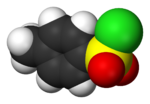Chemistry:4-Toluenesulfonyl chloride

| |

| |
| Names | |
|---|---|
| Preferred IUPAC name
4-Methylbenzene-1-sulfonyl chloride | |
| Other names
Tosyl chloride, p-toluenesulfonyl chloride, p-TsCl, TsCl
| |
| Identifiers | |
3D model (JSmol)
|
|
| ChemSpider | |
PubChem CID
|
|
| UNII | |
| |
| |
| Properties | |
| C7H7ClO2S | |
| Molar mass | 190.65 g/mol |
| Appearance | White solid |
| Melting point | 65 to 69 °C (149 to 156 °F; 338 to 342 K) |
| Boiling point | 134 °C (273 °F; 407 K) at 10 mmHg |
| Reacts with water | |
| Hazards[1] | |
| Main hazards | Releases HCl on contact with water |
| NFPA 704 (fire diamond) | |
| Flash point | 128 °C (262 °F; 401 K) |
Except where otherwise noted, data are given for materials in their standard state (at 25 °C [77 °F], 100 kPa). | |
| Infobox references | |
4-Toluenesulfonyl chloride (p-toluenesulfonyl chloride, toluene-p-sulfonyl chloride) is an organic compound with the formula CH3C6H4SO2Cl. This white, malodorous solid is a reagent widely used in organic synthesis.[2] Abbreviated TsCl or TosCl, it is a derivative of toluene and contains a sulfonyl chloride (−SO2Cl) functional group.
Uses
In characteristic manner, TsCl converts alcohols (abbreviated ROH) into the corresponding toluenesulfonate esters, or tosyl derivatives ("tosylates"):
- CH3C6H4SO2Cl + ROH → CH3C6H4SO2OR + HCl
Tosylates can be cleaved with lithium aluminium hydride:
- 4 CH3C6H4SO2OR + LiAlH4 → LiAl(O3SC6H4CH3)4 + 4 RH
Thus, tosylation followed by reduction allows for removal of a hydroxyl group.
Likewise, TsCl is used to prepare sulfonamides from amines:[3]
- CH3C6H4SO2Cl + R2NH → CH3C6H4SO2NR2 + HCl
The resulting sulfonamides are non-basic and, when derived from primary amines, are even acidic.
TsCl reacts with hydrazine to give p-toluenesulfonyl hydrazide.
The preparation of tosyl esters and amides are conducted in the presence of a base, which absorbs hydrogen chloride. The selection of the base is often crucial to the efficiency of tosylation. Typical bases include pyridine and triethylamine. Unusual bases are also used; for example, catalytic amounts of trimethylammonium chloride in the presence of triethylamine is highly effective by virtue of the trimethylamine.[2]
Other reactions
Being a widely available reagent, TsCl has been heavily examined from the perspective of reactivity. It is used in dehydrations to make nitriles, isocyanides and diimides.[2] In an unusual reaction focusing on the sulfur center, zinc reduces TsCl to the sulfinate, CH3C6H4SO2Na.[4]
Manufacture
This reagent is inexpensively available for laboratory use. It is a by-product from the production of ortho-toluenesulfonyl chloride (a precursor for the synthesis of the common food additive and catalyst saccharin), via the chlorosulfonation of toluene:[5]
- CH3C6H5 + SO2Cl2 → CH3C6H4SO2Cl + HCl
Hazards
Tosyl chloride is considered to be a toxic and corrosive substance.[6]
References
- ↑ "P-TOLUENESULFONYL CHLORIDE (TOSYL CHLORIDE)". http://chemicalland21.com/specialtychem/finechem/p-TOLUENESULFONYL%20CHLORIDE.htm.
- ↑ 2.0 2.1 2.2 Whitaker, D. T.; Whitaker, K. S.; Johnson, C. R.; Haas, J. (2006). "p-Toluenesulfonyl Chloride". Encyclopedia of Reagents for Organic Synthesis. New York: John Wiley. doi:10.1002/047084289X.rt136.pub2. ISBN 978-0471936237. http://onlinelibrary.wiley.com/o/eros/articles/rt136/frame.html. Retrieved 2013-05-28.
- ↑ Ichikawa, J.; Nadano, R.; Mori, T.; Wada, Y. (2006). "5-endo-trig Cyclization of 1,1-Difluoro-1-alkenes: Synthesis of 3-Butyl-2-Fluoro-1-Tosylindole". Organic Syntheses 83: 111. http://www.orgsyn.org/demo.aspx?prep=v83p0111.; Collective Volume, 11, pp. 834
- ↑ Whitmore, F. C.; Hamilton, F. H. (1922). "Sodium Toluenesulfinate". Organic Syntheses 2: 89. http://www.orgsyn.org/demo.aspx?prep=CV1P0492.; Collective Volume, 1, pp. 492
- ↑ Lindner, O.; Rodefeld, L.. "Ullmann's Encyclopedia of Industrial Chemistry". Ullmann's Encyclopedia of Industrial Chemistry. Weinheim: Wiley-VCH. doi:10.1002/14356007.a03_507.
- ↑ 4-Toluenesulfonyl chloride: main hazards
 |


